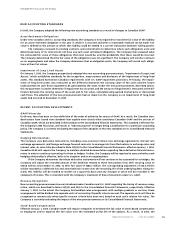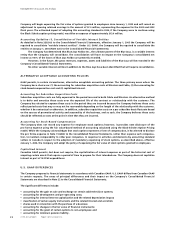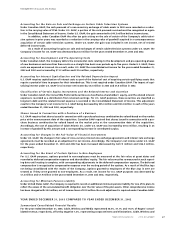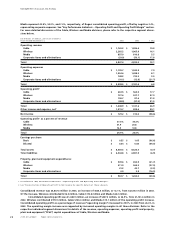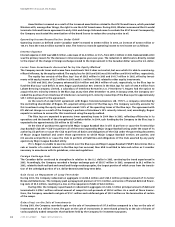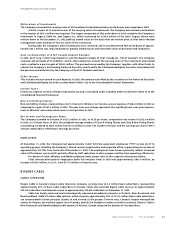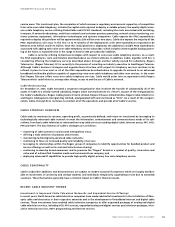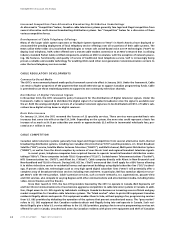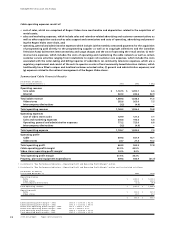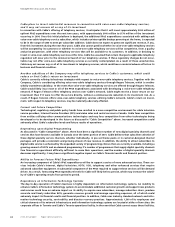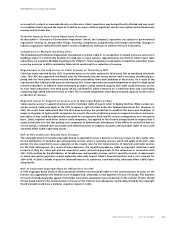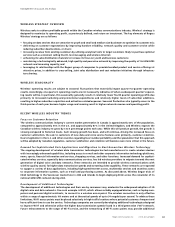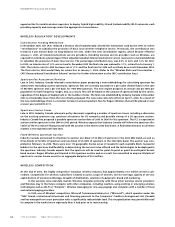Rogers 2003 Annual Report Download - page 36
Download and view the complete annual report
Please find page 36 of the 2003 Rogers annual report below. You can navigate through the pages in the report by either clicking on the pages listed below, or by using the keyword search tool below to find specific information within the annual report.
2003 Annual Report Rogers Communications Inc.
34
Increased Competition from Alternative Broadcasting Distribution Undertakings
As discussed in “Competition” below, Canadian cable television systems generally face legal and illegal competition from
several alternative multi-channel broadcasting distribution systems. See “Competition” below for a discussion of these
various competitive forces.
Development of Cable Telephony Offerings
Many of the larger cable system operators or Multiple System Operators (“MSO”) in North America have deployed or
announced the pending deployment of local telephony service offerings over all or portions of their cable systems. The
MSOs utilize either older circuit switched technologies or newer soft switch-based voice over IP technologies (“VoIP”) to
deploy local telephony. VoIP, when offered over a DOCSIS cable modem connection to an MSO’s network that is utilizing
industry standard Packet Cable certified components, enables an MSO to emulate, with the exception of network power-
ing, the features, functionality and quality of service of traditional local telephone service. VoIP is increasingly being
proven a reliable and scalable technology for enabling MSOs (and other next generation telecommunication carriers) to
enter the local telephony services market.
CABLE REGULATORY DEVELOPMENTS
Community-Based Media
The CRTC’s new community-based media policy framework came into effect in January 2003. Under the framework, Cable
can retain a higher proportion of the payments that would otherwise go to support Canadian programming funds. Cable
is permitted to use these retained payments to support its own community television channels.
Distribution of Digital Television Signals
In November 2003, the CRTC released its policy framework for the distribution of digital television signals. Under the
framework, Cable is required to distribute the digital signal of a Canadian broadcaster once the signal is available over
the air. Both the analog and digital versions of a Canadian television signal are to be distributed until 85% of Cable’s sub-
scribers have digital set-top boxes or digital receivers.
Basic Rate Increase
On January 21, 2004, the CRTC renewed the licences of 22 specialty services. Three services were granted basic rate
increases that come into effect on April 20, 2004. Depending on the system, the new rates could represent a basic fee
increase of as much as $0.13 per subscriber per month or approximately $2.5 million in incremental wholesale fees, pro-
rated at $1.7 million in 2004.
CABLE COMPETITION
Canadian cable television systems generally face legal and illegal competition from several alternative multi-channel
broadcasting distribution systems, including two Canadian Direct-to-Home (“DTH”) satellite providers, U.S. Direct Broadcast
Satellite (“DBS”) service, Satellite Master Antenna Television (“SMATV”), and Multi-channel, Multi-point Distribution System
(“MMDS”), as well as from the direct reception by antenna of over-the-air local and regional broadcast television signals.
In recent years, telephone companies have acquired licences to operate terrestrial broadcast distribution under-
takings (“BDUs”). These companies include TELUS Corporation (“TELUS”), Saskatchewan Telecommunications (“Sasktel”),
MTS Communications Inc. (“MTS”), and Aliant Inc. (“Aliant”). Cable competes directly with Aliant in New Brunswick and
Newfoundland and TELUS in Ontario. During 2003, BCE Inc. (“Bell”) announced that it will apply for a BDU licence allowing
it to deliver television service to residential homes and apartment buildings using digital subscriber line (“DSL”) technol-
ogy. If proven viable, DSL technologies such as very high speed digital subscriber lines (“VDSL”) will potentially offer a
complete array of broadcast television services including VOD and HDTV. In particular, Bell has stated an objective to tar-
get MDU’s with the VDSL product. Cable’s premium services, such as movie networks, U.S. superstations, pay-per-view
and VOD services, also compete to varying degrees with other communications and entertainment media, including home
video, movie theatres and live theatre.
Since their launch in 1997, the two DTH providers licenced by the CRTC to operate in Canada (Bell ExpressVu LLP
and Star Choice Communications Inc.) have become aggressive competitors to cable television systems in Canada. In addi-
tion, illegal access to U.S. DBS signals by individuals residing in Canada has become an increasing source of black and grey
market competition for Canadian cable television systems. The “black market” refers to pirate DBS equipment Canadian
residents illegally obtain and operate. This equipment enables them to take, without paying a fee, programming services
from U.S. DBS providers by defeating the operation of the systems that prevent unauthorized access. The “grey market”
refers to U.S. DBS equipment that Canadian residents obtain and illegally bring into and operate in Canada. Such resi-
dents illegally give a false U.S. service address to the U.S. DBS providers, paying a fee to receive programming services not
offered for sale in Canada. Unauthorized access by Canadian residents with pirate DTH equipment and theft of Canadian
Management’s Discussion and Analysis



